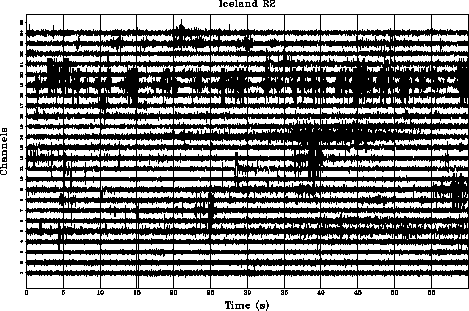![[*]](http://sepwww.stanford.edu/latex2html/cross_ref_motif.gif) .
A 2 ms sampling rate was used, and the length of each record
was one minute.
.
A 2 ms sampling rate was used, and the length of each record
was one minute.
In 1988 the department of experimental seismology at the Institute of Physics of the Earth in Moscow conducted a seismic experiment in Iceland, recording microseismic noise with a 2-D array of geophones. The main purpose of the experiment was to attempt to locate endogenous sources of microseisms beneath the array. Earlier electrical studies had shown that there were possibly hydrotherms at depths around 1 km in the vicinity of the experiment site. It was speculated that these hydrotherms might be good sources of microseismic activity, so an experiment was designed to attempt to locate them using ambient noise data. The velocity structure in the area, determined by conventional seismic surveys, showed the subsurface consisted primarily of horizontal layers.
Conventional seismic recording equipment was used
to record the background noise,
using a two-dimensional array of 24 channels. The array
geometry is shown in Figure ![[*]](http://sepwww.stanford.edu/latex2html/cross_ref_motif.gif) .
A 2 ms sampling rate was used, and the length of each record
was one minute.
.
A 2 ms sampling rate was used, and the length of each record
was one minute.
Preprocessing and data processing were done in Moscow by Shubik and Kisilevitch. The semblance processing has been repeated at Stanford, using SEP software to plot the results.
Raw traces from one record are shown in Figure 1. Some traces are contaminated by strong noise bursts which are not correlated between channels. Since we expect signals from sources at depth to be well correlated, these strong bursts were removed by applying a time-varying automatic gain. The data were also lowpass filtered with a cutoff frequency of 12 Hz.
 |